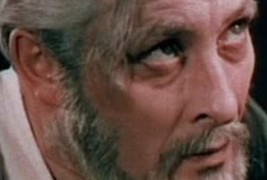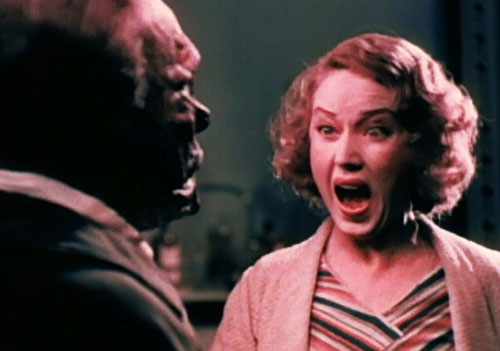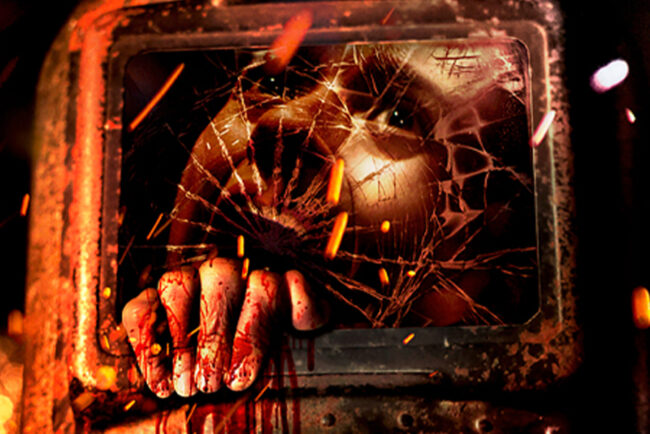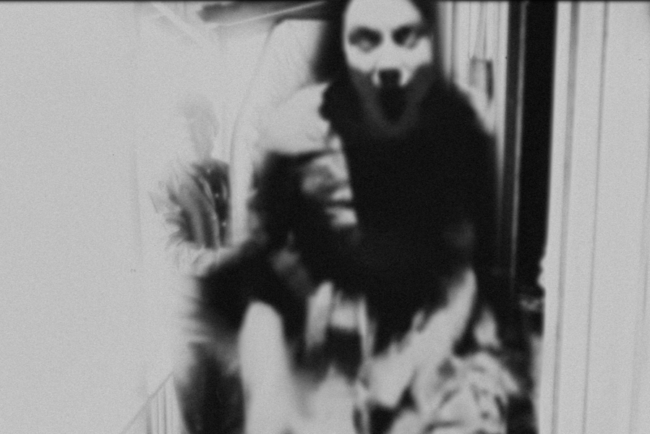
“One side of my face is gentle and kind, incapable of anything but love of my fellow man. The other side, the other profile, is cruel and predatory and evil, incapable of anything but the lusts and dark passions. It all depends on which side of my face is turned toward you—or the camera. It all depends on which side faces the moon at the ebb of the tide.”—Lionel Atwill
When asked to name horror icons of the silver screen, the names of Karloff, Lugosi and Price bob to the surface like bodies in the swamp after a hurricane. The more knowledgeable will add the names of the Chaneys—both Sr. and Jr., as well as Christopher Lee and Peter Cushing. But only the truly erudite horror fanatics will nod at the name of Englishman Lionel Atwill.
I, Dr. Mality, salvager of lost horror treasures, now hope to correct this grievous oversight. The stocky, suavely sinister Atwill was one of the most menacing character actors of the classic age of horror. The man behind that façade was equally fascinating…and some would say almost as sinister. To say Mr. Atwill was a unique individual is a gross understatement. His career ended in lurid scandal and ill health but started in wealth and great promise. Join me now as I look at the man and his works….
Unlike his fellow Englishman and horror icon Boris Karloff, Lionel Atwill was born into a well-to-do family on March 1, 1885 in London, England. He was guided from an early age toward a career as an architect and he retained an interest in that subject his whole life. But the stage fascinated him more and at age 20, he debuted at the prestigious Garrick Theater in London. With his regal bearing and perfect British voice, he became a sensation in a few years. People have forgotten how big of a theater star Atwill was. After moving to New York in 1915, he appeared in over 25 plays on Broadway right up until 1931.
But the new medium of motion pictures also appealed to him and he dabbled more and more in it. After doing some bit parts in silent films, his first real movie was The Silent Witness in 1932. Atwill made for a menacing villain and his wickedly resonant voice translated well to the screen.
After The Silent Witness, the man nicknamed “Pinky” plunged into the world of horror with his very next film, Doctor X. Believed lost for years, the film has obtained a cult reputation even though it really isn’t the best example of Atwill’s talent. He played Dr. Xavier, the “Dr. X” of the title, who was a suspect in a series of grisly cannibal murders committed by a “moon maniac.” It was actually a colleague played by Preston Foster who was guilty of the murders, but Atwill made a strong impression with his controlled yet menacing portrayal of Xavier.
1933 proved to be Atwill’s breakout year which provided him with many memorable roles in horror and mystery. He was Dr. Otto Niemann in The Vampire Bat—a mad scientist who committed murders imitating a vampire so that superstitious villagers would blame the town idiot (played by Dwight Frye) for the crimes. In reality, Niemann used the blood to feed a synthetic lifeform he created. This was the first of several robust mad scientist roles that Atwill would play and he dug into the past with gusto. During 1933, Atwill would be in more horror roles than Karloff and Lugosi combined and seemed to be set to join them at the top of the horror heap.
Next came what I consider the crowning achievement of Atwill’s career, his starring role as sculptor Ivan Igor in The Mystery of the Wax Museum. Like Doctor X, the film came from MGM rather than the dominant horror studio Universal, which gave it a different feel. I consider it one of the great horror films of the ‘30s…a masterpiece of morbidity that inspired the ‘50s remake House of Wax, which launched Vincent Price’s career as “prince of horror”.
Atwill plays Ivan Igor, a brilliant sculptor who is the proprietor of a struggling wax museum in London. When Igor’s unscrupulous partner proposes burning the place down to collect insurance money, Igor vigorously opposes him. The partner viciously knocks Igor out and sets fire to the museum, leaving the sculptor to die. The melting figures of the wax statues look uncomfortably like decaying corpses as the inferno rages. When we next see Ivan Igor, he is wheelchair-bound and preparing to open a new museum in New York. Patrons also remark on how incredibly life-like his wax figures look. Meanwhile, a grave robbing ghoul seems to be stalking the city. When a gutsy female reporter hides in the morgue to catch the body snatcher in the act, she is horrified to see a hideously disfigured monster stealing the dead. This morgue scene is one of the most morbid in the annals of classic horror.
One can perhaps figure out what’s going on, but that doesn’t make The Mystery of the Wax Museum any less entertaining. This was Atwill’s masterwork. It’s hard to believe that even the King of Horror, Boris Karloff, could have played Ivan Igor with a better combination of sympathy and total madness. Another great scene occurs when a fully mobile Igor tries to subdue the beautiful Fay Wray. She hits his face with her fists. The face cracks and falls away, revealing the grotesque horror beneath. Ms. Wray wrote in her autobiography that she had no idea what Atwill’s makeup was. The piercing scream she unleashes was entirely genuine.
The Mystery of the Wax Museum was a big success and Lionel Atwill was the newest horror sensation. His next film helped to cement that reputation. Little remembered now, Murders in the Zoo was considered shockingly violent and lurid in 1933. It gave Atwill one of his most purely evil roles, one he played with great gusto. The role was that of Dr. Eric Gorman, brilliant zoologist and insanely jealous madman. The first scene of the movie gives us a brutal introduction to Gorman: he is shown sewing a man’s lips shut! “You’ll never lie to a friend again, you’ll never kiss another man’s wife,” he tells his victim with relish. The rest of the macabre movie follows Gorman’s campaign of murder against all of his unfaithful wife’s suitors, using his zoo’s deadly animals to achieve his goal.
Murders in the Zoo was one of the more graphic films that triggered the Hayes Code, which enforced strict rules of what could be shown in a movie. For years, it was censored and basically removed from circulation. But people always recalled Lionel Atwill’s visible enjoyment in playing the sadistic Gorman.
While Atwill was busy in front of the camera, he was also never far from the gossip pages and the scandal sheets. The gentleman was known for his…shall we say…”quirky” personality, especially his attitude towards women. He had several marriages and was known to have an eye for the ladies…something that would catch up to him later with devastating effect. One of his marriages ended when a private detective hired by Atwill found the then-Mrs. Atwill in a hotel bed with another actor. His third wife Louise was once married to Gen. Douglas MacArthur and she was one of the biggest socialites in Hollywood, always throwing parties and quick with a quote. Their marriage also ended in divorce, due to some of Pinky’s own “wild” parties. We’ll take a look at that situation in depth later.
Atwill liked to live in style and had numerous fine homes on both east and west coasts. Some of them didn’t fare too well. In 1935, his opulent California mansion burned to the ground. A year later, two Atwill homes on the East Coast fell into the sea after a hurricane. The family fortune kept Atwill well insulated from financial loss and his screen career continued at a frantic pace.
After 1933, when he almost exclusively played mad killers, Atwill tried broadening his roles in the next few years. He had a great part as a villain in 1935’s Captain Blood, the vehicle that propelled Errol Flynn to stardom. Often he was typecast as either a military man or a doctor.
1939 was a huge year for Atwill, as well as Hollywood in general. He landed a juicy part in The Hound of the Baskervilles, which introduced Basil Rathbone as Sherlock Holmes and also grabbed a role in the hit The Three Musketeers. But it was his relatively minor role in Son of Frankenstein that would provide the public with the most lasting image of Lionel Atwill in the movies.
Atwill played the stiff and ultra-Prussian police inspector Krogh in Son of Frankenstein. This is the role that was so brilliantly spoofed by Kenneth Mars in Mel Brooks’ Young Frankenstein years later. With his pointed moustache, monocle and stiff wooden arm, Atwill gave the role of Inspector Krogh everything he had and created an indelible impression of a stern, upright European policeman. The scene where the Frankenstein Monster later tears off Krogh’s wooden arm during a battle is unforgettable. Atwill would go on to play in four more of Universal Frankenstein movies…more than any other actor. He would be the misguided Dr. Bohmer in Ghost of Frankenstein, the Mayor of Visaria in Frankenstein Meets the Wolfman, the very Krogh-like Inspector Arnz in House of Frankenstein and yet another Teutonic policeman, Inspector Holtz, in House of Dracula.
It was in 1940 that Atwill’s personal life—always a subject of rumor—began to overtake his professional life. And thereby destroy both….
In 1939, Lionel and his attractive wife Louise separated. It seems that without a spouse holding him down, “Pinky” could really cut loose and his Malibu mansion became a destination for Hollywood party-goers and swingers. On Christmas Eve 1940, an infamous stag party was held at the Atwill Estate, including nude guests cavorting while pornographic films were shown. Allegations had it that some of the undressed guests were not of legal age. The repercussions from this little bacchanal wound up crippling Atwill’s career. He was brought before a judge on charges of public indecency, which he vehemently denied. He was found guilty of perjury. No jail time was issued but Atwill became a pariah at most Hollywood studios. The stern grip of the Hayes Code reigned over Hollywood and anybody associated with scandal was to be avoided.
Neverthless, Atwill continued his film career, although now he was reduced to low budget programmers like The Mad Doctor of Market Street. He was able to grab appearances in a couple of popular Charlie Chan films and the gangster epic Johnny Apollo. And Universal Studios kept him steadily employed in small roles in the Frankenstein films. This was certainly ironic considering his early horrors Mystery of the Wax Museum and Doctor X were with rival Warner Brothers.
Tragedy now seemed to follow Atwill. The most devastating blow came in 1941. His son John was killed in action in World War II. Despite this, Atwill continued to act and even got some very good roles. One of his best ever came in the acclaimed Ernst Lubitsch comedy To Be Or Not To Be, about the travails of an acting troupe during Nazi occupation. He played the pompous character Rawitsch and showed his ability to spoof his own image.
One of Atwill’s most enjoyable juicy horror performances came in 1941’s Man-Made Monster, a Universal B-movie that also served as a launching pad for Lon Chaney Jr.’s horror career. Atwill was deliciously diabolical at the crazy Dr. Rigas, who turns circus performer “Dynamo Dan the Electric Man” (Chaney) into an electrified zombie. When another character blurts at him, “You must be mad,” Rigas gleefully retorts, “Of course I’m mad! But while you were playing with inventions, I have conquered destiny!” Dr. Rigas is one of the archetypal mad scientists and Atwill nails the part!
Another notable villainous role came in 1942’s Sherlock Holmes and the Secret Weapon. Atwill was one of several actors to take on the role of Sherlock Holmes’ arch-nemesis Prof. Moriarity. This was another part which Lionel seemed born to play.
In 1943, Atwill went back to the courts and admitted that he had lied about the 1940 Christmas party in an attempt to protect family and friends. He did this in the hopes of receiving leniency from the judge. The judge did indeed remove the perjury charge; moreover, he ruled that any “blacklisting” of Atwill by major studios would prevent him from making a living, thereby becoming a cruel and unusual punishment. While the blot was legally lifted from Atwill, the court of public opinion was not so lenient. He would never get a major role again. Even his Universal horror work in House of Frankenstein and House of Dracula was brief and perfunctory—minor roles as a Krogh-like policeman, but without the depth.
By 1945, Atwill’s health was beginning to fail and he was accepting parts in Poverty Row serials. His last actual part was in the atrocious 1946 serial Lost City of the Jungle. Perhaps mercifully, Lionel Atwill died of pneumonia in April of 1946, aged 61. He left behind his fourth and last wife and numerous children.
At one time, Atwill was considered an actor with the potential of a John Gielgud or Laurence Olivier. Though he didn’t achieve those heights, those who enjoy classic character actors and particularly the great old horror films of yore are well aware of his contributions. It’s hard to imagine any of the Universal Frankenstein films without his presence and his work in Mystery of the Wax Museum ranks with the most iconic horror performances ever.
I and all fellow horror mavens here at Ravenous Monster salute the dignified but demented roles of the one and only Lionel Atwill!
6 thoughts on “The Rise and Fall of Lionel Atwill”
Comments are closed.



















Never realized Atwill and scream queen legend Fay Wray appeared together in so many films. Doctor X, Mystery of the Wax Museum, The Vampire Bat.
Sorry to nitpick, but you’ve confused Lost City of the Jungle with the 1935 serial, The Lost City. The racist plot you described is from the earlier chapterplay – Lost City of the Jungle has a much more pedestrian plot about secret agents trying to secure a rare radioactive element.
My mistake! I will have that corrected!
Great review of one of my favorite bad guys, Lionel Atwill. Thanks for the memories.
Note* “On Christmas Eve 1940, an infamous stag party was held at the Atwill Estate, including nude guests cavorting while pornographic films were shown. Allegations had it that some of the undressed guests were not of legal age.”
The term “allegations”… Ultimately they attempted to charge him with purgery, for not ‘copping’ to ‘public’ indecency. Yet the story say is happened at his “Estate”. I find it all suspect. Did they name names of other guests who were cavorting? He gave us many iconic personas that many of us will cherish. I’ll have to see much more annotated accounts to give this the credence is has suspiciously earned thus far.
Thanks for this writeup! Today is Lionel Atwill day on TCM, and I’ll be taping Doctor X and Mystery of the Wax Museum tonight!